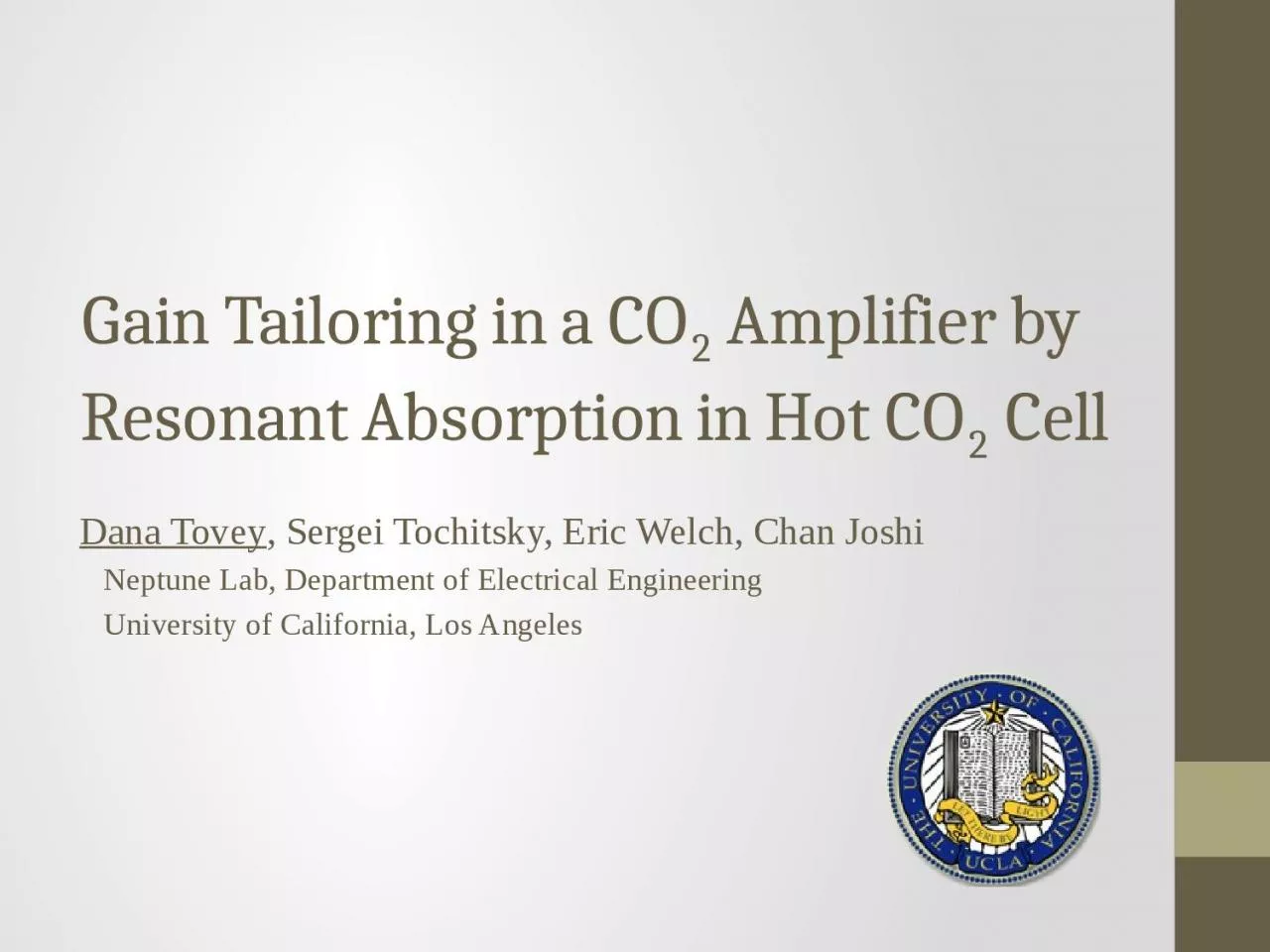

Amplifier by Resonant Absorption in Hot CO 2 Cell Dana Tovey Sergei Tochitsky Eric Welch Chan Joshi Neptune Lab Department of Electrical Engineering University of California Los Angeles ID: 918864
Download Presentation The PPT/PDF document "Gain Tailoring in a CO 2" is the property of its rightful owner. Permission is granted to download and print the materials on this web site for personal, non-commercial use only, and to display it on your personal computer provided you do not modify the materials and that you retain all copyright notices contained in the materials. By downloading content from our website, you accept the terms of this agreement.
Slide1
Gain Tailoring in a CO2 Amplifier by Resonant Absorption in Hot CO2 Cell
Dana Tovey, Sergei Tochitsky, Eric Welch, Chan Joshi Neptune Lab, Department of Electrical Engineering University of California, Los Angeles
Slide2Why is this Important?UCLA
Neptune Lab: World’s most powerful (15 Terawatt) Carbon Dioxide laserHigh peak power can only be generated with very short, picosecond (10-12
second) pulses
When
10 micron laser beam is focused, it produces very strong electrical fields
Applications
Generation
of Light Channels in Air (laser weapon)
Particle
Acceleration
(cancer
treatment)
Laser Fusion
(potential unlimited energy source
)
Slide3Amplification of Short Pulses
Input
Time Domain
Time Domain
Frequency Domain
Smooth Gain Spectrum (Ideal)
Modulated Gain Spectrum (Realistic)
Amplified Output
3
ps
3
ps
18
ps
Time
Time
Time
Time
Frequency
Frequency
Slide4Pressure broadening
At higher pressure, spectral lines grow wider and overlap, smoothening the spectrumBroader bandwidth means shorter pulsesPossible SolutionsIncrease pressure (technologically difficult)
Use CO
2
isotopes to fill gaps in spectra (expensive)
CO
2 Laser Gain Spectra
CO
2
Absorption Spectrum at 1
atm
CO
2
Absorption Spectrum at 10 atm
~ 1 THz
Slide5My Project
CO
2
Laser
CO
2
Hot Cell
gain
loss
E
upper
E
lower
gain
loss
gain − loss
input
Slide6Numerical SimulationsTo simulate the effect of a hot cell, I used an open-source code “co2amp” designed to model amplification of short pulses in active CO
2 media [1]Calculates amplitude and phase at each individual frequencyConditions for laser were realistic, given by past experimental resultsGain coefficient: 2.2%/cmPressure: 8
atm
(1:1:14 CO
2
:N
2:He mix)Cell Length: 50 cmSimulated amplification of 3
ps pulse from 1 μJ to 1 mJRegenerative amplifier: Number of passes varied depending on amount of absorption by hot cell
[1] Mikhail N. Polyanskiy, "co2amp: A software program for modeling the dynamics of ultrashort
pulses in optical systems with CO2 amplifiers," Appl. Opt. 54, 5136-5142 (2015)
Slide7Optimization3 main variables to optimize for the hot cell
Gas Mix (CO2 : N2 : He)TemperatureTotal PressureGas Mix: all results indicate pure CO2 (1:0:0) works best
Optimizing Temperature
Fixed CO
2
Pressure = 2
atm
Optimizing Pressure
Fixed Temperature = 400 K
Slide8Simulation ResultsConditions taken from realistic experimental results
Gain coefficient: 2.2%/cmLaser Pressure: 8 atm (1:1:14 CO2:N2:He mix)Cell Length: 50 cm
Output without Hot CO
2
Cell
Output with Hot CO
2
Cell
Slide9Project StatusThis academic year I plan to work 8-10 hours/week continuing this project
Design for hot cell is completeCurrently contacting companies about the building of customized partsGoal: To build the hot cell and test this theory in lab by the conclusion of this academic year
Hot CO
2
Cell
L = 50 cm
Brewster’s Angle for
NaCl
= 56°
Salt Window
Salt Window